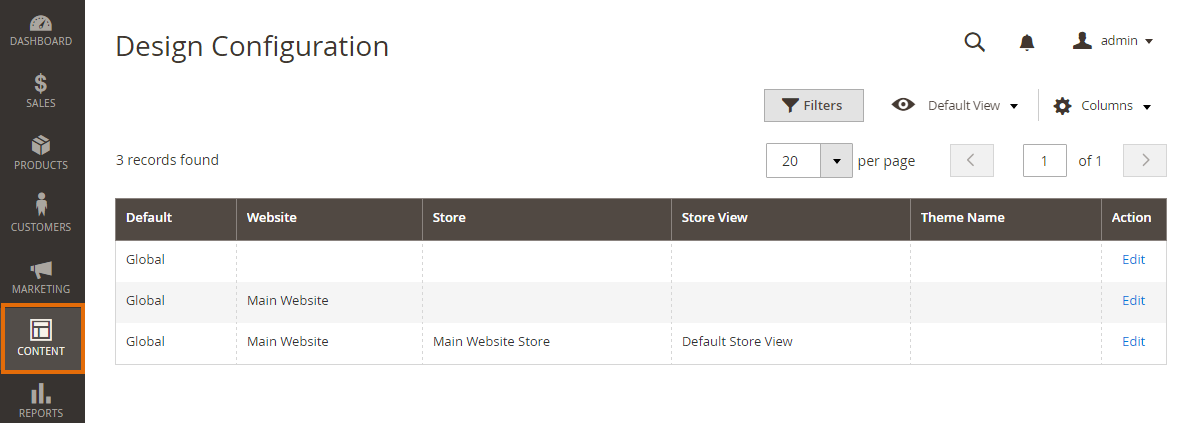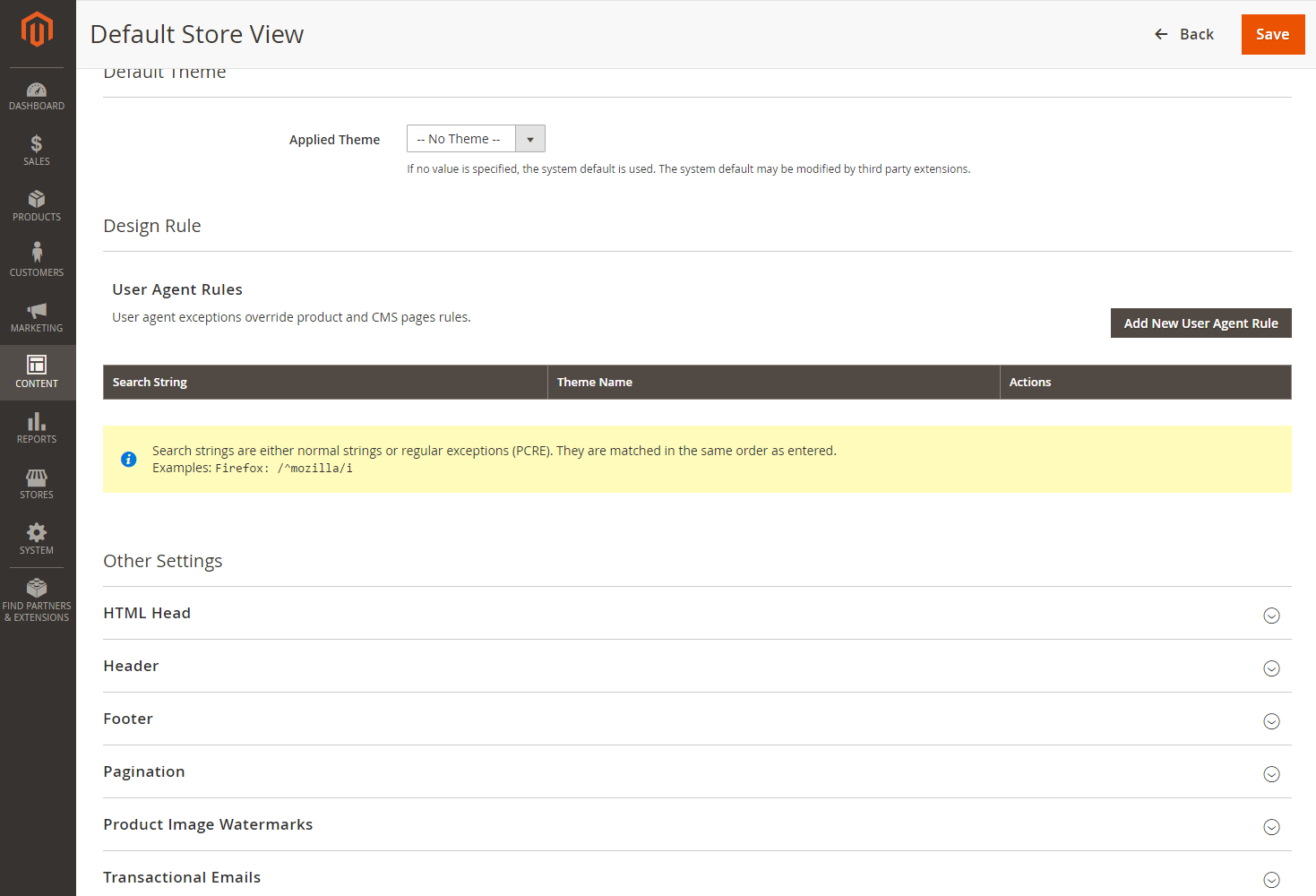Customize Design Configuration
What's in this topic
This topic describes how to customize (add, delete, change) the configuration options available in Magento Admin under CONTENT > Design > Configuration. These options define the various aspects of storefront design. In Magento 2.0.x and earlier these options were set under STORES > Configuration > Design. But starting from Magento 2.1.0 they were moved to the new location, and the configuration form was refactored.
Overview
In Magento out of the box, when you navigate to CONTENT > Design > Configuration in Admin, the first page that opens displays a grid with the available configuration scopes and assigned themes. It looks like following:

When you click Edit in any of the scope records, the page with available design options is displayed. For example, the default set of design options for the store view level is the following:

Both the grid and the configuration form are implemented using UI components.
To change the grid view, you need to customize the grid configuration by adding your custom design_config_listing.xml in your module.
To change the available design settings you need to customize the grid configuration by adding your custom design_config_form.xml in your module. If you add a new field, you must also declare it in di.xml how it is processed and saved.
View the following sections for details.
Customize the grid
The grid containing the configuration scopes is implemented using the grid UI component.
To customize the grid view, take the following steps:
-
In the
<your_module_dir>/view/adminhtml/ui_componentdirectory, add the emptydesign_config_listing.xml. -
In the
design_config_listing.xmlfile, create aelement to in which to add your customizations. For example, if you want to rename the column displaying the selected theme, your grid configuration must contain the following:
<?xml version="1.0" encoding="UTF-8"?>
<listing xmlns:xsi="http://www.w3.org/2001/XMLSchema-instance" xsi:noNamespaceSchemaLocation="urn:magento:module:Magento_Ui:etc/ui_configuration.xsd">
<columns name="design_config_columns">
<column name="theme_theme_id">
<argument name="data" xsi:type="array">
<item name="config" xsi:type="array">
<item name="label" xsi:type="string" translate="true">%New theme column name%</item>
</item>
</argument>
</column>
</columns>
</listing>Your design_config_listing.xml is merged with the same files from the other modules. So there is no need to copy their content, you only need to define changes. Even if you want to customize the existing entities, you only have to mention those options, the values of which are customized.
For reference, view the grid configuration files of the Magento modules:
<Magento_Backend_module_dir>/view/adminhtml/ui_component/design_config_listing.xml<Magento_Theme_module_dir>/view/adminhtml/ui_component/design_config_listing.xml
If you add a certain field as additional grid column, you also need to set the field’s use_in_grid property in the field’s meta data in di.xml.
Customize the design options
Customize the form configuration
Design configuration form is implemented using the form UI component.
To customize the form view, take the following steps:
-
Create an empty
design_config_form.xmlfile in the<your_module_dir>/view/adminhtml/ui_component/directory. -
Add content similar to the following:
<form xmlns:xsi="http://www.w3.org/2001/XMLSchema-instance" xsi:noNamespaceSchemaLocation="urn:magento:module:Magento_Ui:etc/ui_configuration.xsd">
<fieldset name="%fieldset_name%">
<argument name="data" xsi:type="array">
<item name="config" xsi:type="array">
<item name="label" xsi:type="string" translate="true">%Fieldset Label as displayed in UI%</item>
<item name="sortOrder" xsi:type="number">%order for displaying%</item>
</item>
</argument>
<!--Field sets can be nested -->
<fieldset name="%nested_fieldset_name%">
<argument name="data" xsi:type="array">
<item name="config" xsi:type="array">
<item name="label" xsi:type="string" translate="true">%Nested fieldset Label as displayed in UI%</item>
<item name="collapsible" xsi:type="boolean">true</item>
<!-- Nesting level, the value should correspond to the actual nesting level in the config xml file. For the top field set level = 0 -->
<item name="level" xsi:type="number">%level of nesting%</item>
</item>
</argument>
<field name="%field_name%">
<argument name="data" xsi:type="array">
<item name="config" xsi:type="array"
<item name="%field_option1%" xsi:type="%option_type%">%value%</item>
<item name="%field_option2%" xsi:type="%option_type%">%value%</item>
....
</item>
</argument>
</field>
</fieldset>
</fieldset>
</form>Your custom fields and field sets will be available for all configuration scopes (website, store, and store view).
Your design_config_form.xml is merged with the same files from the other modules. So there is no need to copy their content, you only need to add your customizations.
To customize an existing entity, declare only those options, the values of which are customized, do not copy its entire configuration. For example, if you only want to rename the Other Settings field set, your form configuration must contain the following:
<?xml version="1.0" encoding="UTF-8"?>
<form xmlns:xsi="http://www.w3.org/2001/XMLSchema-instance" xsi:noNamespaceSchemaLocation="urn:magento:module:Magento_Ui:etc/ui_configuration.xsd">
<fieldset name="other_settings">
<argument name="data" xsi:type="array">
<item name="config" xsi:type="array">
<item name="label" xsi:type="string" translate="true">Other Settings</item>
</item>
</argument>
</fieldset>
</form>To delete an existing field, or field set, in your design_config_form.xml use the following syntax:
...
<fieldset name="%fieldset_name%">
<argument name="data" xsi:type="array">
<item name="disabled" xsi:type="boolean">true</item>
</argument>
</fieldset>
...For reference, view the form configuration files of Magento modules:
<Magento_Backend_module_dir>/view/adminhtml/ui_component/design_config_form.xml<Magento_Catalog_module_dir>/view/adminhtml/ui_component/design_config_form.xml<Magento_Email_module_dir>/view/adminhtml/ui_component/design_config_form.xml<Magento_Swatches_module_dir>/view/adminhtml/ui_component/design_config_form.xml<Magento_Theme_module_dir>/view/adminhtml/ui_component/design_config_form.xml
Add fields’ metadata
If in the design configuration form you add new fields, in <your_module_dir>/etc/di.xml you must specify their parent field sets and the path in the database. You can also declare the backend model used for processing the field values. If you do not specify any model, the default Magento\Framework\App\Config\Value model is used.
The field declaration in a di.xml looks like following:
...
<type name="Magento\Theme\Model\Design\Config\MetadataProvider">
<arguments>
<argument name="metadata" xsi:type="array">
<!-- field name as described in configuration -->
<item name="%field name%" xsi:type="array">
<!-- the path to the field in system configuration storage in DB-->
<item name="path" xsi:type="string">%path in system config%</item>
<!-- the name of field set for current field, as described in form configuration -->
<item name="fieldset" xsi:type="string">%parent_fieldset%</item>
<!-- The php model used for field value processing -->
<item name="backend_model" xsi:type="string">%Backend\Model\For\\Field\Processing%</item>
<!-- Define whether the field value is displayed in the Design Configuration grid -->
<item name="use_in_grid" xsi:type="boolean">true|false</>
<item name="base_url" xsi:type="array">
<item name="type" xsi:type="string"></item>
<item name="scope_info" xsi:type="string"></item>
<item name="value" xsi:type="string"></item>
</item>
</item>
</argument>
</arguments>
</type>
...Example of field declaration:
<type name="Magento\Theme\Model\Design\Config\MetadataProvider">
<arguments>
<argument name="metadata" xsi:type="array">
<item name="head_shortcut_icon" xsi:type="array">
<item name="path" xsi:type="string">design/head/shortcut_icon</item>
<item name="fieldset" xsi:type="string">head</item>
<item name="backend_model" xsi:type="string">Magento\Config\Model\Config\Backend\Image\Favicon</item>
<item name="base_url" xsi:type="array">
<item name="type" xsi:type="string">media</item>
<item name="scope_info" xsi:type="string">1</item>
<item name="value" xsi:type="string">favicon</item>
</item>
</item>
</argument>
</arguments>
</type>For more examples and reference, view the di.xml files of the Magento modules:
<Magento_Backend_module_dir>/etc/di.xml<Magento_Catalog_module_dir>/etc/di.xml<Magento_Email_module_dir>/etc/di.xml<Magento_Swatches_module_dir>/etc/di.xml<Magento_Theme_module_dir>/etc/di.xml
Accessing the options values in backend models
The design configuration option values are stored in the core_config_data table in the database, similar to the values of System Configuration options, and can be accessed using the \Magento\Framework\App\ConfigInterface mechanism.